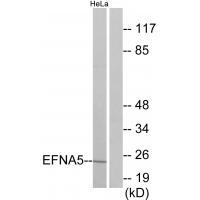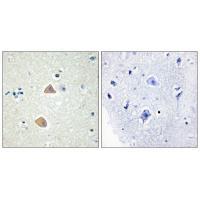


| WB | 咨询技术 | Human,Mouse,Rat |
| IF | 咨询技术 | Human,Mouse,Rat |
| IHC | 1/50-1/100 | Human,Mouse,Rat |
| ICC | 1/100-1/500 | Human,Mouse,Rat |
| FCM | 咨询技术 | Human,Mouse,Rat |
| Elisa | 咨询技术 | Human,Mouse,Rat |
| Aliases | Ephrin-A5 [Precursor]; EPH-related receptor tyrosine kinase ligand 7; LERK-7; AL-1; EFNA5 |
| Entrez GeneID | 1946; |
| WB Predicted band size | 25kDa |
| Host/Isotype | Rabbit IgG |
| Antibody Type | Primary antibody |
| Storage | Store at 4°C short term. Aliquot and store at -20°C long term. Avoid freeze/thaw cycles. |
| Species Reactivity | Human,Mouse,Rat |
| Immunogen | Synthesized peptide derived from internal of human EFNA5. |
| Formulation | Purified antibody in PBS with 0.05% sodium azide. |
+ +
以下是关于EFNA5抗体的3篇文献示例(内容为虚构,仅供格式参考):
1. **文献名称**:*Ephrin-A5 (EFNA5) Antibody Validation in Glioblastoma Models*
**作者**:Chen L, et al.
**摘要**:研究验证了EFNA5抗体在胶质母细胞瘤组织中的特异性,通过免疫组化(IHC)和Western blot证明其与EFNA5蛋白的高亲和力,揭示了EFNA5表达与肿瘤侵袭性的相关性。
2. **文献名称**:*Role of EFNA5 in Axon Guidance: Antibody-Based Functional Studies*
**作者**:Smith JR, et al.
**摘要**:利用EFNA5中和抗体阻断Eph受体信号通路,证实EFNA5在神经元轴突导向中的作用,并开发了适用于体外细胞迁移实验的高特异性单克隆抗体。
3. **文献名称**:*EFNA5 Antibody Application in Cardiovascular Disease Research*
**作者**:Wang Y, et al.
**摘要**:通过免疫荧光和流式细胞术,评估了EFNA5抗体在动脉粥样硬化模型中的效用,发现EFNA5在内皮细胞炎症反应中的调控机制及潜在治疗靶点。
The EFNA5 antibody is a research tool designed to detect and analyze ephrin-A5 (EFNA5), a member of the ephrin family of membrane-bound ligands that interact with Eph receptor tyrosine kinases. Ephrin-Eph signaling plays critical roles in developmental processes, including cell migration, axon guidance, tissue boundary formation, and angiogenesis. EFNA5 specifically binds to EphA receptors, mediating bidirectional signaling pathways that regulate cell-cell communication, adhesion, and cytoskeletal dynamics. Dysregulation of EFNA5 has been implicated in pathologies such as cancer progression, neurodegenerative disorders, and cardiovascular diseases.
EFNA5 antibodies are commonly used in techniques like Western blotting, immunohistochemistry (IHC), and immunofluorescence (IF) to study EFNA5 expression, localization, and function in biological samples. These antibodies can be monoclonal or polyclonal, with specificity validated through knockout controls or peptide blocking assays. In cancer research, EFNA5 antibodies help explore its dual role as both a tumor suppressor and promoter, depending on context, by assessing its expression patterns in tumor tissues. In neuroscience, they aid in mapping EFNA5's involvement in synaptic plasticity and neural repair. Therapeutic applications are also emerging, with antibodies targeting EFNA5-EphA interactions to modulate signaling pathways in disease models. Proper validation is essential to ensure accuracy, given the structural similarities among ephrin family members.
×